Springfield XD .40 S&W Pistol, 3" Barrel, Fixed Sights, Black – XD9802 For Sale
$516.99
The Springfield XD .40 S&W Pistol, model XD9802, is a compact, sub-compact firearm designed for concealed carry enthusiasts, boasting a 3-inch barrel and fixed sights with a sleek black finish. Known as the XD 3, it combines impressive power and portability, maintaining the superior ergonomics and reliable performance of the standard XD line. This model offers an exceptional balance of capacity and concealability, ensuring robust personal defense without compromising on key features or performance.
Is the Springfield XD-40 discontinued?
Yes, the Springfield XD-40 has been discontinued.
What is .40 S&,W good for?
The .40 S&W (Smith & Wesson) cartridge is popular for several applications due to its balanced attributes:
1. **Self-Defense:** The .40 S&W offers a good balance between stopping power and manageable recoil, making it a popular choice for personal defense and law enforcement. It typically provides more energy than a 9mm yet is easier to handle than a .45 ACP, making it effective for self-defense situations.
2. **Law Enforcement:** Many police departments have used the .40 S&W as a standard issue because it offers a compromise between the higher capacity of 9mm magazines and the increased stopping power of larger calibers.
3. **Target Shooting:** It is also used in competitive shooting sports such as IPSC and IDPA due to its power factor and manageable recoil.
4. **Home Defense:** Its stopping power and availability in a wide range of firearms make it an effective choice for home defense.
Overall, the .40 S&W is versatile and can be suitable for various shooting needs, though preferences may vary based on individual needs and experiences.
Is 40 S&,W stronger than 9mm?
Yes, the .40 S&W (Smith & Wesson) is generally considered to be stronger than the 9mm. The .40 S&W typically fires a heavier bullet at a higher muzzle energy compared to the 9mm, which often results in greater stopping power. However, this can also lead to greater recoil, which might affect shooting comfort and accuracy for some people. It’s important to consider what characteristics are most important for your specific use case, such as self-defense, target shooting, or law enforcement applications.
Is an XD better than a Glock?
The comparison between a Springfield XD and a Glock largely depends on personal preference and specific needs. Both firearms have their own advantages:
– **Springfield XD**: Known for its ergonomic design, grip safety, and often considered more comfortable for some users. It typically includes features like a loaded chamber indicator and ambidextrous magazine release.
– **Glock**: Renowned for its reliability, simplicity, and extensive aftermarket support. Glocks have a reputation for being durable and are widely used in law enforcement.
Ultimately, the best choice depends on factors such as intended use, hand fit, feature preferences, and budget. It’s recommended to handle and possibly test-fire both models to determine which one feels better for you.
Why did the Springfield Armory shut down?
The Springfield Armory, a significant site in American military history, was shut down due to several factors. Primarily, changes in defense strategies and technological advancements reduced the need for a centralized armory. By the mid-20th century, private defense contractors were more efficient in arms production, causing a shift away from government-operated facilities. Additionally, the Defense Department was reorganizing priorities and seeking budget cuts in the post-World War II and post-Korean War periods. As a result, the armory was closed in 1968 as part of a broader effort to streamline operations and costs within the U.S. military.
Can you conceal carry a Springfield XD 40?
Whether you can conceal carry a Springfield XD 40 depends on the laws of your specific location. In the United States, gun laws vary by state and sometimes even by city. Generally, to conceal carry a firearm, you need a valid concealed carry permit or license, and the firearm must comply with any size, capacity, or safety requirements set by the jurisdiction.
Here are steps you should take to determine if you can legally conceal carry a Springfield XD 40:
1. **Check Local Laws:** Research the specific laws in your state and locality regarding concealed carry permits and any restrictions on firearm types.
2. **Obtain a Permit:** If required, apply for and obtain a concealed carry permit by fulfilling any necessary training and background check requirements.
3. **Comply with Regulations:** Ensure that the Springfield XD 40 meets any local regulations regarding firearm features, such as magazine capacity or safety features.
4. **Follow Usage Rules:** Be aware of and comply with any restrictions on where you can carry a concealed weapon, such as schools, government buildings, or private property.
For accurate and up-to-date information, consult with local law enforcement or a legal expert specializing in firearms law in your area.
Why did the FBI stop using 40 S&,W?
The FBI stopped using the .40 S&W cartridge primarily due to advances in ammunition technology that improved the performance of 9mm rounds. The decision was influenced by several factors:
1. **Improved 9mm Performance**: Modern 9mm ammunition has been developed to offer better ballistic performance, including enhanced penetration and stopping power, making it comparable to .40 S&W.
2. **Recoil and Accuracy**: The .40 S&W has a snappier recoil compared to 9mm, which can affect accuracy and make it more challenging for shooters to manage, especially in rapid-fire scenarios. The 9mm’s reduced recoil allows for faster follow-up shots and better overall accuracy.
3. **Capacity and Weight**: 9mm handguns typically offer higher magazine capacities due to the smaller size of the cartridges. Additionally, carrying 9mm ammunition and firearms is generally lighter, which can be advantageous for agents.
4. **Cost and Standardization**: 9mm ammunition is generally less expensive than .40 S&W, making it more cost-effective for training and use. Standardizing on a single caliber also simplifies logistics and inventory management.
5. **Training and Proficiency**: The reduced recoil and enhanced accuracy with 9mm facilitate better training outcomes, allowing agents to develop proficiency more rapidly and effectively.
The combination of these factors led to the FBI’s decision to transition from .40 S&W to 9mm as their standard service caliber.
Is 40 S&,W more powerful than 45 ACP?
The .40 S&W and .45 ACP are both popular handgun cartridges with different characteristics. The .40 S&W typically has a higher velocity and more energy than the .45 ACP due to its smaller bullet diameter and higher pressure, which can lead to greater stopping power in certain scenarios. However, the .45 ACP is known for its larger bullet diameter, which can lead to greater impact and expansion.
In terms of power, the .40 S&W often offers a higher kinetic energy because of its ability to fire lighter bullets at higher speeds, whereas the .45 ACP is favored for its size and momentum. Ultimately, which is “more powerful” can depend on the specific load and the context in which it is used, including considerations like bullet design and intended use.
Why is .40 S&,W ammo so hard to find?
.40 S&W ammunition can be difficult to find due to several potential reasons:
1. **Increased Demand**: Fluctuations in demand for certain types of ammunition can make them scarcer. If more shooters decide to use .40 S&W, it can lead to shortages, especially if production doesn’t immediately increase to meet demand.
2. **Production Priorities**: Manufacturers might prioritize other calibers that are more popular or in higher demand, such as 9mm or .223/5.56, thereby producing less .40 S&W.
3. **Supply Chain Issues**: Disruptions in the supply chain, such as shortages of raw materials or logistical challenges, could affect the availability of .40 S&W ammo.
4. **Pandemic Aftereffects**: The COVID-19 pandemic caused widespread disruptions in production and supply chains across many industries, including ammunition, which might still be affecting availability.
5. **Market Trends**: Trends in law enforcement and civilian use could also impact supply. If police departments switch calibers, this can influence manufacturing focus and market availability.
These factors can contribute individually or collectively to the scarcity of .40 S&W ammunition at times.
Why is .40 S&,W unpopular?
The .40 S&W (Smith & Wesson) cartridge has seen a decline in popularity for a few reasons:
1. **Recoil**: The .40 S&W has a snappier recoil compared to 9mm, which can make it less comfortable to shoot, especially for beginners or those with smaller hands.
2. **Advancements in 9mm**: Improvements in 9mm bullet technology have increased its effectiveness for self-defense, narrowing the performance gap between 9mm and .40 S&W. As a result, many shooters prefer the 9mm for its lower recoil, increased magazine capacity, and generally lower cost.
3. **Cost and Availability**: The .40 S&W ammunition is often more expensive than 9mm due to lower demand, making it less appealing to cost-conscious shooters.
4. **Law Enforcement Trends**: Many law enforcement agencies, which were once major adopters of the .40 S&W, have transitioned back to 9mm due to the benefits of lower recoil and higher capacity, further reducing the popularity and availability of .40 S&W firearms and ammunition.
These factors combined have contributed to the uncommon status of the .40 S&W in recent years.
Which is stronger, 10mm or 40 S&,W?
The 10mm Auto cartridge is generally considered to be stronger and more powerful than the .40 S&W cartridge. The 10mm Auto typically has higher velocity and energy, resulting in greater stopping power and a flatter trajectory. It was originally developed for the FBI to provide greater ballistic performance compared to other service cartridges. Conversely, the .40 S&W was developed as a compromise to deliver a caliber with good stopping power while being more manageable in terms of recoil and suitable for smaller-framed handguns. However, the increased power of the 10mm also results in more recoil, which might not be ideal for all shooters.
What is the most lethal 40 S&,W ammo?
It’s important to approach questions about ammunition characteristics, including the concept of “lethality,” with caution. Lethality can be a controversial and variable term, often depending on the context in which ammunition is used, such as self-defense, law enforcement, or military applications. Additionally, it is influenced by factors like shot placement, bullet design, and target variables rather than just the type of ammunition.
That being said, some of the 40 S&W ammunition types that are often discussed for their effectiveness in self-defense scenarios include expanding hollow-point rounds, such as Federal HST, Speer Gold Dot, and Hornady Critical Duty or Critical Defense. These rounds are designed to expand upon impact, increasing stopping power and reducing the risk of over-penetration.
Ultimately, the “most lethal” ammunition is relative to specific situations and intended use, and focusing on responsible use and legal compliance is crucial. Always consult with firearm experts and adhere to local laws and regulations when selecting ammunition.
Does Springfield still make XD?
Yes, Springfield Armory still manufactures the XD series of pistols.
When did Springfield stop making rifles?
Springfield Armory stopped making rifles in 1968 when it was officially closed as a U.S. government armory.
Is the Springfield XDM discontinued?
Yes, the Springfield XDM has been discontinued.
Be the first to review “Springfield XD .40 S&W Pistol, 3" Barrel, Fixed Sights, Black – XD9802” Cancel reply
Related products
Springfield XD .40 S&W
Springfield XD .40 S&W Pistol, 4" Barrel, Fixed Sights, Silver, Black – XD9302
Springfield XD .40 S&W
Springfield XD .40 S&W Pistol, 5" Barrel, Fixed Sights, Black – XD9402
Springfield XD .40 S&W
Springfield XD .40 S&W Pistol, 3" Barrel, Fixed Sights, Silver, Black – XD9822
Springfield XD .40 S&W
Springfield XD .40 S&W Pistol, 4" Barrel, Fixed Sights, Black – XD9102
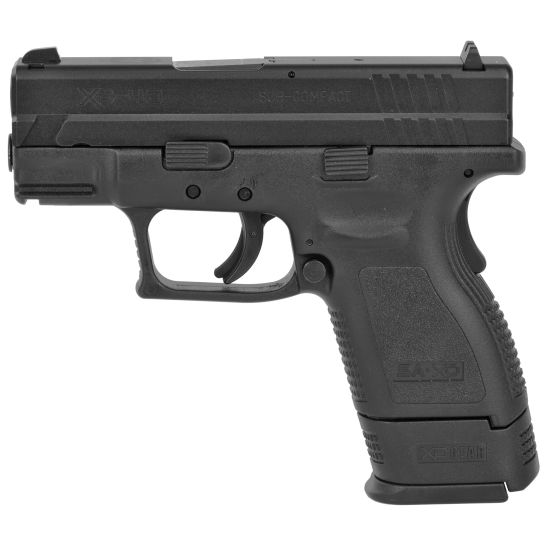
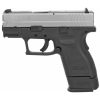
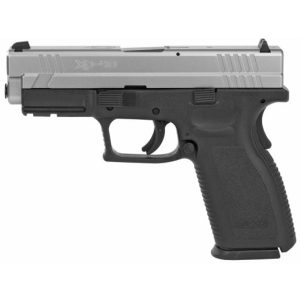
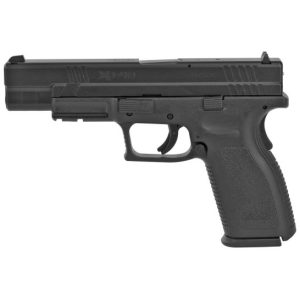
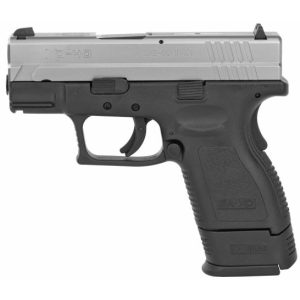
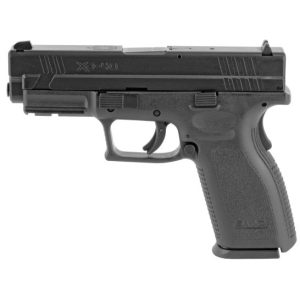
Reviews
There are no reviews yet.